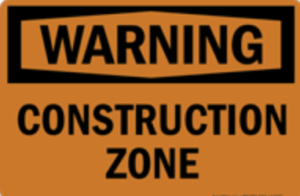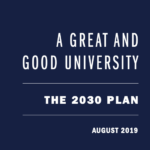Sometimes, things just force their way into your consciousness.
My wife and I were in Charlottesville this weekend. We were not there to visit the University, but its continuing construction overwhelms both the senses and attempts to get from A to B. Most of the growth is vertical — very vertical — on land that the University owns on or adjacent to the central Grounds.
Drive down Jefferson Park Avenue for a sense of the scale of it. Look straight up. Go to the intersection of Rt. 29 and 250 to see a new 14-acre complex under construction.
There is a sense that there is never to be an end to it.
There is certainly nothing to suggest a considered approach to growth in the University’s Strategic Plan. Sinclair Lewis recognized the symptoms a century ago.
No room was found in the Plan for any possibility of stopping doing something for which there is no longer sufficient demand in order to do something new in existing buildings.
Instead, University infrastructure growth seems on a self-generating loop — an idea for a new building, the land identified, a search for donors, an alumnus writes a check to buy immortality (unless the donor is later “cancelled” by the left), and voilà, some of the initial funding, if not the long-term sustaining money, is found. Skilled construction workers are brought in by the contractors who build at such scale, who then leave when the job is complete.
Replay.
But there is no sense at all that the region’s very costly and limited housing stock and its small blue-collar workforce can provide long-term support to that infrastructure. Having reviewed the aforementioned Strategic Plan, I see no evidence that the University has considered that issue.
To be blunt, the growth is designed to satisfy the faculty, not the students and their parents. Just look at who was on the committee that wrote the strategic plan: professors of this and deans of that. And one fourth-year student in the Commerce school.
I rest my case.
But it is students and their parents who will forever pay the constantly inflating costs of keeping it all running. But they can borrow the money to attend. And to live in Charlottesville.
What could go wrong?
Charlottesville’s housing stock is very old and limited in availability, thus increasingly expensive. The city’s population is projected by UVa’s own Weldon Cooper Center to be flat through 2050.
Supply and demand imbalances being what they are, rents in the area have skyrocketed. Apartments near the University are $1,100 a month, minimum. If one can be found at that price. More are in the $1,500- to $2,000-a=month range. Another hundred a month for a parking place.
The Albemarle County population is projected by Weldon Cooper to grow by about 40,000 by 2050, but property and housing costs there are also expensive and will inflate with rising demand.
None of those trends scream blue collar workforce.
Future students will have to pay the bills for the costs of operation, maintenance, and repair of that vast and continually growing infrastructure.
There is no concept apparent in University planning for where the skilled workers necessary to support the infrastructure will come from or where they will live. The plumbers, electricians, HVAC technicians, elevator repair people, building engineers, and many more types of skilled tradespersons.
The University may not have noticed, but the country is incredibly short of skilled blue-collar workers. Wages have skyrocketed since Covid, but the shortages remain.
Does the University have some secret source of such workers amidst a general scarcity? Does it have an unseen inventory of housing that they can afford and in which they can raise their families?
I reread the University’s strategic plan, and there is no reference to that issue. When the plan discusses service-oriented students, the authors do not mean plumbers.
Charlottesville, at only 10 square miles in area, is built out. The housing stock is very old. The median year that owner-occupied structures were built is 1960. Renter-occupied, 1977.
Albemarle County, at 720 square miles with 112,000 residents, has plenty of land, and its housing stock is newer compared to Charlottesville. But the land is very expensive. And NIMBY is alive, well, and very influential in that wealthy enclave.
The prices of recent housing sales in both Charlottesville and Albemarle County continue to escalate, with the median sold price up almost 8% in July of 2023 from one year earlier.
In Charlottesville itself, residential real estate sold in July at $240 per square foot. That is double the national average of $124 per square foot. The median average value of residential real estate in Charlottesville is $465,527. Statewide it is $372,973,
Bottom line. I have several issues with the constant, mindless expansion.
- The University is creating new supply of permanent and inflating infrastructure and associated staffing costs without any apparent assessment of the long-term magnitude of those costs to students;
- There is no evidence in new construction plans of any consideration of how much demand for education and research is shifting as opposed to just expanding;
- There is no evidence of consideration of alternatives to new construction such as shrinking other offerings to accommodate changing demands for education and research. They are keeping the buggy whip faculty (no offense to buggy aficionados) while building new cars;
- The University has offered no public consideration of the source or costs of the skilled labor to maintain and repair the ever-growing infrastructure. Or where they will live;
- There also appears to be no care for the contribution of the construction and the energy demands of the new buildings to the climate change about which the faculty are so passionate in the classroom. The University exempts itself from those concerns. They are for others less entitled.
Ok, you want a new school of data science. Who wouldn’t?
But what is being taught and what research is being done in the vast inventory of existing buildings? Is there nothing for which there is a lesser demand than there once was? Nothing that can be cut back to accommodate data science?
Are there no classes that few attend?
Is there research on, say, ancient Greek literature (no offense to the Greek authors) or neo-pronouns (no offense to the ever-expanding list of pronouns) that is, or should be, exhausted but continues anyway?
The only sure things from the evidence are:
- UVa tuition will continue to rise at a rate above Virginia incomes;
- Student housing costs, because of local market conditions, will rise perhaps even faster than tuition;
- Students and their parents will have to borrow yet more money to pay those bills.
But that is clearly of no concern of the University faculty or administration, ever- watchful of their own career prospects and the costs of arugula and craft gin.
The Board of Visitors is hounded and their time dominated by loud and insistent special interests from within the University, who provide them only sketchy briefings on their plans, having themselves ignored internally the more troublesome issues.
The University seldom seems to get to consideration of the long-term best interests of students, including but not limited to affordability.
Because, from the evidence at hand, the interests of students seldom arise in conversations, much less plans.



Leave a Reply
You must be logged in to post a comment.